
Efforts of masons preserve San Juan walls
SAN JUAN, P.R. — Walking between El Morro and San Cristóbal forts in Old San Juan, visitors are transported back to a more idyllic time nearly a half-millennium ago.
The masons of the San Juan National Historic Site (SJNHS) work up a sweat everyday to ensure that this historical atmosphere is still palpable. In an architectural age of steel and glass, an appreciation for Old World construction can be difficult to come by, but these men truly take pride in their responsibility as protectors of the historical and cultural heritage of the people of San Juan.
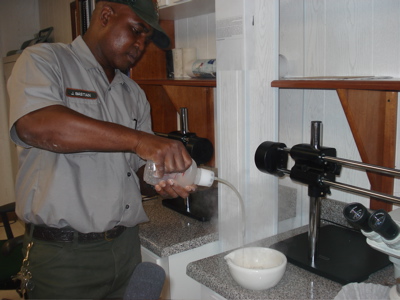 |
San Juan National Historic Site masonry worker José “Cheo” Bastian demonstrates the lime-slaking process (Photo by Danielle McNally).
|
“Old San Juan is a place where a lot of people come from everywhere, so we want to keep the historic site looking nice for the visitors,” said Miguel Vázquez, a mason for the National Park Service based in San Juan. “It’s our heritage. I want the people to leave with a good impression of our place.”
Beyond just basic day-to-day maintenance and upkeep, these men have had to become experts in the technological aspects of building preservation and restoration in order to maintain the historical integrity of the site.
A combination of the natural elements surrounding the forts and modern influences has caused parts of the structure, built in the 16th and 17th centuries, to deteriorate and eventually fall. It is the job of these dedicated masons to restore the wall to as close to its original greatness as possible – using original techniques and materials.
“We have modern masons that work in concrete and cement, but we select the best ones – the ones we know have real good techniques – to go through lime masonry workshop for about two years until they learn the materials,” said SJNHS Facility Manager Edwin Colón, who has spent 28 years working in construction.
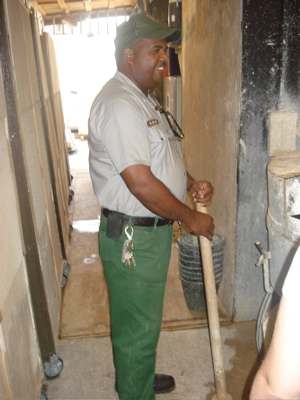 |
“Beating the mix” is a 16th century lime mortar technique that SJNHS masonry workers like Ramón “Papo” de Jesús must study and learn (Photo by Danielle McNally). |
“It is completely different to work with lime mortars than cement-based mortars. This is mostly tradition. It’s been used for 5,000 years, but since the early 1900s we’ve lost the tradition of working with lime-based mortars because concrete is a lot easier and faster. When you work with lime mortars, it takes more experience, better techniques,” he added.
According to Jose “Cheo” Bastian, who has been a masonry worker at the SJNHS for eight years and risen to the level of master mason, the limestone walls have a sponge-like quality, making it a material that needs to breath. However, before being aware of the walls’ characteristics, the U.S. Army put cement over dilapidated areas. This cement acted like a seal and actually hurt the walls’ natural internal structure.
“Lime relies a lot on moisture,” said Bastian. “If you put a layer of cement on the limestone walls, it will shut the walls down and inside will become a powder. And the wall will die inside.”
Along with this moisture comes salt.
“Salt comes in from the sea like a cloud every morning,” said Bastian.
The salt from the seawater gets inside the limestone; when it dries it becomes crystal. It oxidizes and expands and if sealed in by cement, breaks the bricks.
|
Papo de Jesús shows off some of the tools hand-made by SJNHS masons (Photo by Danielle McNally). |
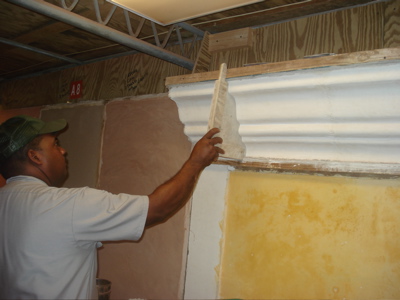 |
“The moisture that we let the wall get is just enough to let the wall breathe in and then go out, but if saltwater stays inside too long it will damage the wall,” added Bastian.
Since cement and lime don’t mix, the NPS masons are required to spend two years training in a laboratory where they study the 16th century materials and building techniques Colón explained. That way when they do have to repair damaged parts of the wall, they are not compromising the wall itself, but rather restoring it to its original state.
“We can’t go out and contract for preservation and masonry because, many times, it’s not done accurately,” said Walter Chavez, superintendent of the SJNHS. “But it takes at least two years to learn how to do the wall preservation properly. For a while we we’re able to hire permanent staffers, so as soon as they got trained it would be time for them to leave.”
Over the past three years, however, the park was able to add seven permanent masonry workers to the staff. And the program has been making great strides since then.
“Now we have a top-notch preservation staff that is becoming known around the states and in other parks,” said Chavez.
The strength of the preservation staff’s knowledge of 16th century materials and techniques has become so recognized in their industry that masons such as Bastian and his co-worker, Ramón “Papo” de Jesús, have traveled to other locations to talk about their techniques.
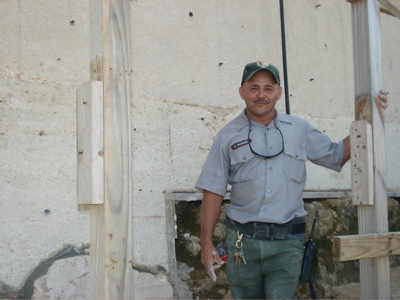 |
During a break from re-facing a damaged portion of the old city wall, SJNHS mason Miguel Vázquez smiles for the camera (Photo by Danielle McNally). |
In addition they have been asked to host educational workshops to teach architects, fellow masons, and experts in preservation technology what they have learned through their training and research at the SJNHS.
On a weekend that University of Miami students were visiting, the NPS masons were hosting a workshop for the Association for Preservation Technology focused on “Old World Technologies Adapting in the New World.” The subject of their workshop was traditional lime and crushed brick mortars for restoration.
At this workshop, Bastian and Colón taught participants about the lime-slaking process, pulverized brick preparation and mortar application. It takes a thorough understanding of each of these steps to ensure the most cohesive assimilation of the original stones and the new bricks and mortars.
“As masons, we go out and get a sample from the area where the work needs to be done and then we have to make a replica as close as we can to that sample,” explained Bastian. “We know that if we maintain the same material, mortar, etcetera, the wall will receive it and it’s going to be like nothing happened there. It’s going to keep going the same way it has for 500 years.”
Colón explained that after the sample has been examined and tested in the lab, the newly created replica goes through what is known as lime-slaking to make lime putty. This is the substance to which the aggregate (sand or brick dust) is added to make the mortar or plaster. Afterwards, masons “beat the mix” to make it softer for application.
|
SJNHS masonry worker Orlando Medina is hard at work re-facing a part of the wall that fell over a year ago (Photo by Danielle McNally). |
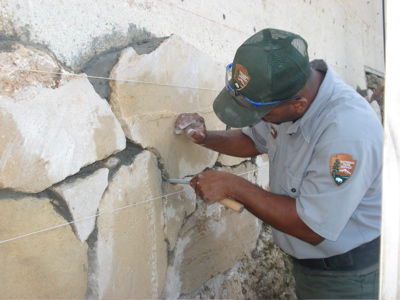 |
The “beating the mix” step is the only part of the restoration process that is not done completely with Old World technologies. De Jesús demonstrated how in the 16th century mason would spend up to two weeks literally beating a mix of lime putty and aggregates by hand to make mortar. Today the masons in San Juan use two machines known as the crusher and the pulverizer to make up to 70 buckets of mix per day.
“But we teach the traditional way first,” Colón explained. “During their training, masons spend a week or two weeks beating the mix by hand. This way we know they’ll take care of the machinery, because they know if it breaks down they’re going back to doing it by hand.”
Despite this small use of modern technologies, every thing else is done in a way that is the most historically accurate. Masons even create their own application tools by hand.
Although the work of a mason at the SJNHS is a lot of hard physical labor, the smiles seen on the masons’ faces are sure indications that they are not only aware of the importance of the work they do, but truly enjoy doing it.
“The more I get involved in historical preservation work, the more I like what I’m doing,” said Bastian.
If You Go
Although the research lab is not officially open to visitors, the maintenance staff of the park is happy to tell visitors about the work they do. If you would like to know more, contact Edwin Colón at 787-729-6777.
| Members of the maintenance staff pose with student writers. From left: Papo de Jesús, Erin Schlissel, Kelly Asher, Nestor Ortíz, Caitlin Trowbridge, José Flores, author Danielle McNally, and Miguel Vázquez (Photo by Edwin Colón). |
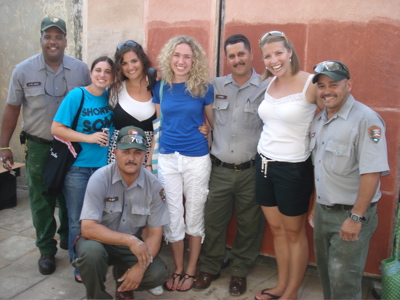 |

Comments are Closed